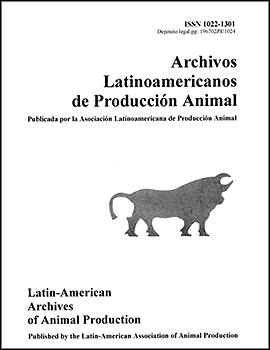
|
Archivos Latinoamericanos de Produccion Animal
Asociacion Latinoamericana de Produccion Animal
ISSN: 1022-1301
EISSN: 1022-1301
Vol. 13, No. 1, 2005, pp. 19-23
|
 Bioline Code: la05003
Bioline Code: la05003
Full paper language: Portuguese
Document type: Research Article
Document available free of charge
|
|
|
Archivos Latinoamericanos de Produccion Animal, Vol. 13, No. 1, 2005, pp. 19-23
| en |
Use of some mathematical models to study the lactation curveof Murrah buffaloes and their crossbressbreds under a semi-extensive system in the state of São Paulo
M. Muñoz-Berrocal, H. Tonhati, M. Cerón-Muñoz, J.M.C. Duarte, R.L. Chabariberi
Abstract
In the present study, five mathematical models, two of which were linear: linear hyperbolic (FLH) and quadratic logarithmic (FQL); and three non linear: parabolic exponential (FPE), incomplete gamma (FIG), and inverse polynomial (FIP), were used to determine which of them gave best fit to the mean lactation curve, using data from three buffalo herds of the Murrah breed and its crossbreds, under a semi-extensive production system employing twice daily milking. Information was obtained on 3267 lactations, including 27600 test day milk weights. Milk testing was done at 30-day intervals over the period from 1990 to 2001. Lactations utilized in the analysis were based on a minimum of four and maximum of nine test days. Criteria used to verify the goodness of fit of the curve generated by each model were: adjusted coefficient of determination (R2A), lack of fit test (LDF), and graphs of the distribution of residuals and of residual lag. The highest R2A 86.29%, was obtained with both FQL and FLH, which also yielded the lowest residuals and not significant results (P>0.05) in the LOF test.
Keywords
Buffaloes, Lineal Hyperbolic, Quadratic Logarithmic, Parabolic Exponential, Incomplete Gamma, Inverse Polynomial.
|
| |
| pt |
Uso de modelos lineares e não lineares para o estudo da curva delactação em Búfalos Murrah e seus mestiços em sistema de criação semi extensivo, no Estado de São Paulo
M. Muñoz-Berrocal, H. Tonhati, M. Cerón-Muñoz, J.M.C. Duarte, R.L. Chabariberi
Resumo
No presente estudo as funções Lineares: Linear Hiperbolica (FLH), Quadrática Logarítmica (FQL), e as não lineares: Parabólica Exponencial (FPE), a Gama Incompleta (FGI), e Polinomial Inversa (FPI), foram usadas com o objetivo de avaliar qual função ajusta melhor a curva de lactação média, usando dados de três rebanhos bubalinos da raça Murrah e seus mestiços criados baixo o sistema semi extensivo com duas ordenhas diárias. Considerou-se informações de 3267 lactações, referentes a 27600 controles de produção de leite. O controle leiteiro foi feito em intervalos de 30 dias, no período de 1990 a 2001. As lactações utilizadas continham no mínimo quatro e no máximo nove controles. Os critérios utilizados para verificar a qualidade do ajuste para cada função foram, o Coeficiente de Determinação Ajustado (R2A), o Teste de Lack of Fit (LOF) , o gráfico de distribuição de resíduos e o gráfico de Lag de resíduos. Os melhores coeficientes de determinação foram 86,29% para as FQL e FLH, produzindo os menores resíduos, e LOF não significativos (P<0,05).
Palavras-chave
Búfalos, Linear Hiperbolica, Quadrática Logarítmica, Parabólica Exponencial, Gama Incompleta, Polinomial Inversa.
|
| |
© © 2005 - ALPA. Arch. Latinoam. Prod. Anim.
Alternative site location: http://www.alpa.org.ve/ojs/index.php
|
|
